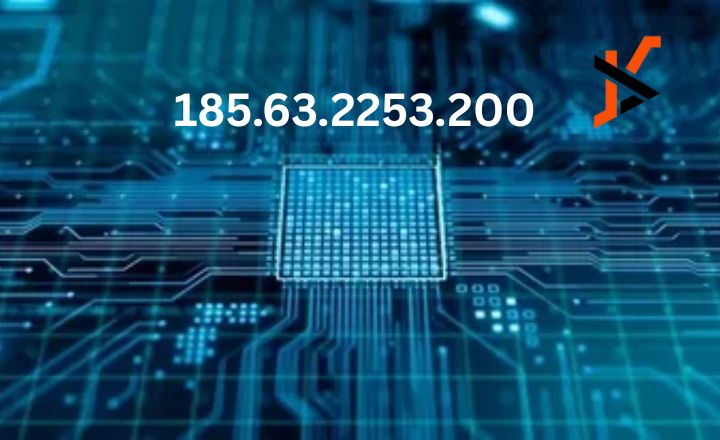When we use the internet, we often think about websites, apps, and services, but behind the scenes, a complex system of numbers enables everything to function smoothly. Central to this system is the IP address, which serves as the digital address of every device online. One example of an IP address is 185.63.2253.200, which is similar to the string of numbers you might encounter in technical setups or while troubleshooting.
This article dives into what IP addresses are, how they work, their different types, and their importance in making the internet reliable and efficient.
What is an IP Address?
An IP address (Internet Protocol address) is a unique numerical identifier assigned to every device connected to a computer network that uses the Internet Protocol. Think of it like your home address – it tells other systems where to send data. Without IP addresses, communication between devices on the internet simply wouldn’t work.
Key Components of an IP Address
- It consists of numbers separated by dots (e.g., 192.168.1.1).
- Typically, IP addresses are structured using the IPv4 or IPv6 formats.
Example of an IP Address
A typical IPv4 address might look like this:
- 185.63.2253.200
An IP address is more than just a series of numbers; it’s the foundation of online communication, enabling devices to transmit and receive data effectively.
Types of IP Addresses
IP addresses come in different forms depending on their purpose and setting. Here are the main types:
1. Private vs. Public IP Addresses
- Private IP Address
These are used within private networks (e.g., at home or in offices). They allow devices within the same network to communicate but are not accessible outside that network.
Examples:
-
- 192.168.1.1
- 10.0.0.1
- Public IP Address
These are assigned by Internet Service Providers (ISPs) to identify devices on the larger internet. They enable communication with devices beyond private networks.
2. Static vs. Dynamic IP Addresses
- Static IP Address
-
- Permanent and does not change over time.
- Typically used for servers, where a consistent address is essential.
- Dynamic IP Address
-
- Assigned by ISPs and often changes periodically.
- Common for home users.
| Feature | Static IP | Dynamic IP |
|————————-|—
| Cost | Higher | Lower |
| Reliability for Hosting | Excellent | Moderate |
| Change Frequency | Never | Regular |
3. IPv4 vs. IPv6
The transition from IPv4 to IPv6 is significant as the internet grows.
- IPv4 (Internet Protocol version 4)
-
- Addresses are 32 bits long.
- Example: 185.63.225.200
- Limited to approximately 4.3 billion unique addresses.
- IPv6 (Internet Protocol version 6)
-
- Addresses are 128 bits long.
- Example: 2001:0db8:85a3:0000:0000:8a2e:
0370:7334 - Allows for trillions of unique addresses, resolving IPv4’s scarcity.
Why Does the Format of IP Addresses Matter?
The structure of IP addresses ensures devices follow a universal language when communicating. A correctly configured address (e.g., 185.63.225.200) guarantees data reaches its destination without errors.
How Do IP Addresses Work?
Every time you access a website, send an email, or stream a video, IP addresses facilitate the communication process. Here’s an easy breakdown of how they work:
- Device Identification
IP addresses are assigned to every device connected to a network.
- Data Routing
With the help of routers and ISPs, data is sent to the correct recipient based on their IP address.
- DNS and IP Translation
Domain names like turbotechify.com are linked to numerical IP addresses (e.g., 185.63.225.200). This translation is handled by the Domain Name System (DNS), making the internet user-friendly while maintaining efficiency.
- Responses
When a user requests a webpage, the website’s server sends the requested content to the user’s IP address.
Why Are IP Addresses Important?
Without IP addresses, the internet couldn’t function. Here’s why they are so vital:
- Device Communication
Whether you’re on a smartphone, a desktop, or a smart TV, an IP address ensures your device can send and receive data.
- Troubleshooting Internet Issues
IP addresses like 185.63.225.200 can help diagnose connectivity problems. For example, using tools like “ping” or “traceroute” can verify if a device is reachable online.
- Network Security
Blocking or monitoring specific IP addresses can help prevent cyber threats.
Fun Fact
Every time you browse the web, your IP address is visible to the websites you visit. This is how content is tailored to your location and preferences. Learn more on TurboTechify.
Common Issues with IP Addresses
Like any technical component, IP addresses can sometimes cause problems. Here are some of the most common challenges users face:
1. IP Address Conflicts
Occurs when two devices on the same network are assigned the same IP address. This results in connectivity issues.
Solution:
- Restart your router.
- Assign static IPs to critical devices.
2. Blocked IP Address
Public IPs can sometimes be blocked by websites or servers due to harmful activities or security settings.
Solution:
- Use a VPN to obtain a new public IP address.
- Reach out to the server host to resolve the issue.
3. Misconfigured Subnets
Incorrect setup of subnets can limit communication between devices.
Solution:
- Verify the subnet mask configuration matches all devices on the network.
Tools for Troubleshooting IP Addresses
Here are some free tools to help you analyze or troubleshoot IP addresses like 185.63.225.200:
- Ping – Checks if a device is reachable online.
- Traceroute – Shows the path data packets take to reach a specific address.
- IP Lookup Services – Identifies the ISP and location associated with an IP.
The Future of IP Addresses
With the rapid expansion of IoT (Internet of Things) and smart devices, IP addresses have become more critical than ever. While the adoption of IPv6 has solved the IP shortage, new challenges such as enhanced security and efficient data routing continue to push advancements in networking.
Whether you’re managing a personal network at home or operating a large-scale enterprise, understanding IP addresses is essential.
Learn and Optimize with TurboTechify
If you’d like to learn more about optimizing your network, troubleshooting connectivity, or maintaining online security, visit TurboTechify. Our resource hub is packed with guides, tools, and the latest updates on internet technology.
Key Takeaways
- An IP address functions as a unique identifier for devices online, much like a home address.
- Examples of IP addresses include 185.63.225.200 (IPv4) and 2001:0db8::1 (IPv6).
- IPs are critical for seamless internet communication, ensuring that data reaches its recipient accurately.
- Troubleshooting tools like ping or traceroute can help resolve common IP-related issues.
- The transition to IPv6 is paving the way for a more scalable and secure internet future.
Whether you’re a tech enthusiast or simply someone curious about how the internet works, mastering the basics of IP addresses enriches your understanding of the digital world. For more insights, tips, and tutorials, be sure to explore the wealth of knowledge available at TurboTechify.


